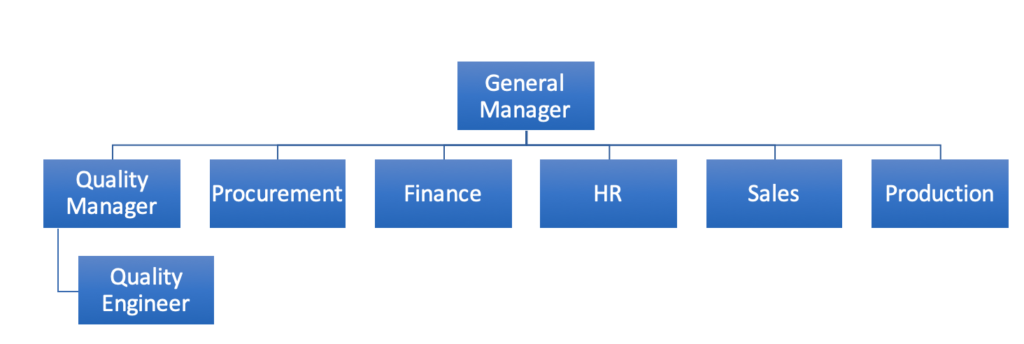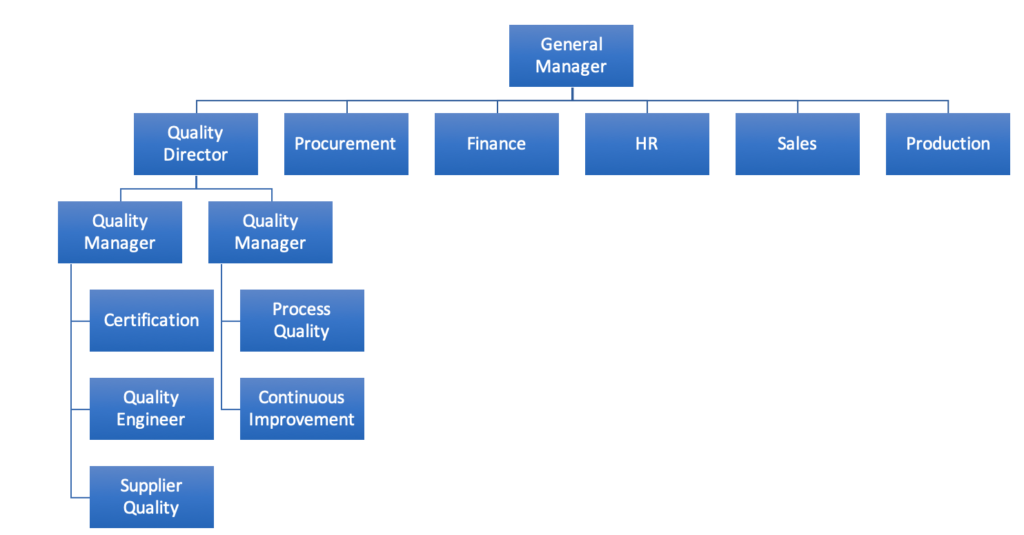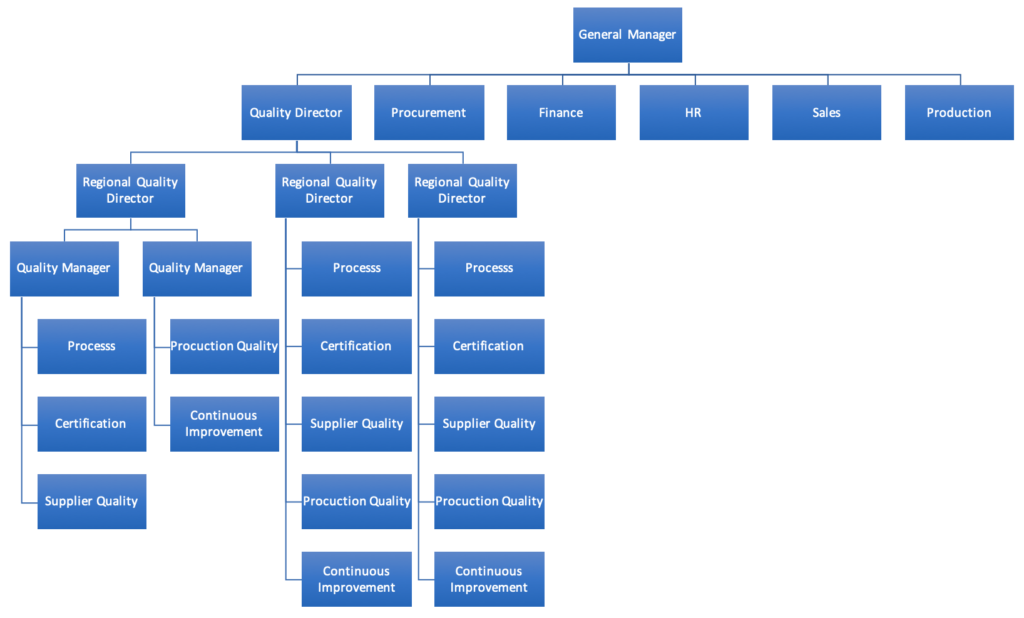
A typical quality assurance reporting structure varies on several factors, including the company’s size, applicable regulatory requirements and general organizational structure (i.e. team-based or hierarchical).
Some roles may be specific when assessing a quality assurance reporting structure; for example, dependent on the industry. However, many roles are functionally driven and are therefore common for example:
- Functional leadership & Governance
- Regulatory management/controls
- Continuous improvement
In today’s article, we’ll be looking at the Quality Assurance reporting structure. We’ll be covering:
- What is a quality assurance reporting structure
- How to design a typical Quality Assurance organization
- Best practice considerations
- How to deploy an appropriate quality assurance reporting structure
- Key benefits through adopting a quality assurance reporting structure
- Common issues associated with the quality assurance reporting structure.
What is a Quality assurance reporting structure?
A Quality Assurance reporting structure is the term used to describe the organizational construct of the Quality function within a business.
Like many functions, the principles that apply to quality will often partly define the reporting structure that is present. For example, quality requires a reporting line to the organization’s General Manager or Leadership executive, it requires linkages into each function within the business; these may be direct (such as in a matrix organization) or implied via specific roles and responsibilities.
Consider, for example, the Aerospace industry; it’s common to have Supplier Quality Engineers (SQEs) working alongside the supply chain to execute activity relating to the procurement of materials. These SQE’s will usually report to the Quality organization but have responsibilities within a different function (in this case, supply chain).
A key planning requirement is that to execute its responsibilities and authority, the QA executive requires a “direct line of sight” from its own function to the rest of the organization.
How to design a typical Quality Assurance organization
When commencing the design of your quality organization, there are several planning inputs to consider:
1/ What are the quality organizations goals
A typical quality function might include several of the following:
- Quality Strategy
- Certification
- Performance
- Safety
- Delivery
- Customer Service
When designing your organization, you’ll need to structure it around what you’re trying to achieve, ensuring appropriate functional responsibility and support in each appropriate area.
2/ How will it interface with the rest of the business
This is likely to be multi-layered. Consider, for example –
- How will the Quality strategy align with other functional strategies?
- How will processes be captured and controlled?
- How will you coordinate cross-functional activities when undertaking certification?
- How will you drive cross-functional continuous improvement?
Such decisions are likely to drive the shaping of your organization.
You should start with some key assumptions such as:
- Information must be free-flowing
- Quality must not hinder (but instead enhance)
- Access to the quality function must be simple
- Responsibilities must be clear
3/ How is the rest of the organization structured
A further key consideration is how your organization is already structured. For example, perhaps it has adopted a matrix structure.
How does your proposed structure sit with what’s already there? Can you see opportunities, or instead, do you see easily generated issues that may hamper delivery?
4/ The size of your organization
This is likely to be split three ways:
a) Small businesses
For a small business, your organization is likely to be driven by your regulatory needs. In many regulated industries (i.e. aerospace, pharmaceutical), requirements exist for specific roles (i.e. a dedicated quality manager).
In general, the quality team is likely to be small, perhaps just one or two members of staff. Given the size of the team, they are likely to wear various hats from compliance, safety, improvement etc.

The organization’s size does not stop you from instilling the appropriate culture into the organization and driving quality ownership by everyone. Indeed there are several opportunities available to small businesses, not least that the business is of a size where communication should be highly effective.
There are, of course, challenges; teams have to be very focused on what can be achieved (given size) and counter common issues that small businesses bring (immature processes, time-challenged functions, emerging certification evidence).

b) Medium-Sized Organizations
While still relatively small, the quality function in a medium-sized organization is likely to be comprised of a leadership function supported by a team that executes the strategy.
It is still common for the Quality team to be generalized (i.e. wear many hats), and you’ll usually find it centralized.
Due to size constraints, the focus tends to be centred on compliance and improvement.

c) Large orgnaizaitons
In a large organization that might have several thousand staff, your reporting structure is likely to look somewhat different from a small organization.
Firstly there are likely to be several layers of management and likely the formation of several distinct quality teams (especially if the organization is geographically dispersed).
The team structure is likely to be driven by the need to solve specific large organization issues such as:
- Communication
- Management layers
- Multi-site/location (perhaps spread across multiple countries)
- regulatory control
- Certification related issues
- Risk & Opportunity
At this stage, you are likely to have
- Executive-level quality leaders/directors
- Multiple Quality teams
- Multiple Managers
- Large numbers of Quality Engineers
- Regulatory responsibility spread across the organization
- Areas of specialism (i.e. training)
- As a multi-team approach deploying best practice across multiple sites.

Best practice considerations
When looking at best practice, it’s a good idea to break the function down into specific activities rather than look at it as one solid mass. This will enable you to plan improvements and achieve goals faster.
Perhaps one of the best methods of evaluating your reporting structure is through a series of challenging questions, such as:
- How will governance be established?
- How will you support certification/regulatory needs?
- How will you make decisions?
- How will responsibilities get divided between the team?
- How will team members be compelled to perform?
- How will the organization process information?
- How will you develop cross-organizational relationships?
- How will you share best practice?
- How will you develop competitiveness?
- How will you enable transformation
- How will you support goals around organizational culture
How to deploy an appropriate quality assurance reporting structure
Once you’ve defined your reporting structure, you’ll then want to deploy it.
Implementing a new organizational reporting structure in an existing business is often termed transformation as it describes the process of transforming something into something else.
You should see transformation as more than just describing a reporting structure, and there are various tasks with significant importance in the approach (and it’s not for the faint-hearted!). Some of the steps you’d want to consider are:
- Agreeing your goals and priorities
- Drafting your reporting structure
- Assessing job/skill requirements
- Selecting staff
- Agreeing and implementing a change plan
- Training (where required)
- Rolling out the change
- Monitoring performance and making adjustments where required
If you’re starting a new business and looking to establish your Quality assurance reporting structure, you are faced with a similar set of tasks, albeit you will be faced with a differing set of issues than you’d face with change.
Whatever environment you’re establishing your assurance organization into, rest assured it’ll require careful thought upfront, a plan to implement and a method of monitoring to ensure it’s successful.
Key benefits through adopting a quality assurance reporting structure
There are several benefits including:
- Clear governance
- A route to decision making
- Improved communications
- More effective employee performance
- Clear roles and responsibilities (which is vitally important when considering things like regulatory issues).
- Reduced conflict.
Common issues associated with the quality assurance reporting structure.
Of course, as we all know, reporting structures are not immune from issues, and where they are weak, they can lead to significant obstacles. So what should you look out for? Here are some common themes
- Ownership over decision making is not clear through the structure
- Middle management heavy – too many supervisors/managers and not enough people executing value add tasks
- Poor recruitment into roles resulting in poor performance (not precisely the issue of the structure but a common issue nonetheless
- The structure is not aligned to deliver organizational goals
- The team do not buy into the structure and do their own thing
- Structure inhibits communication and/or teamwork
- Best practice is not shared
Summary
The Quality assurance reporting structure defines the structure of the Quality department within an organization.
There are multiple ‘types’ of structure that could be adopted depending on the industry requirements and size of the organization.
The structure needs to be aligned with organizational goals, and businesses should recognize that it is not a fire and forget activity, and it’ll require monitoring and tuning to ensure it’s effective.
What reporting structure has your Quality organization adopted? Are you functional-based, or are you based on a matrix style organization?
Have you a large team, or is it a small number of staff focussed on a broad range of activities?
As ever, we’d love for you to share your lessons learned and best practice.
You can reach us via the comments section below or via Twitter.
